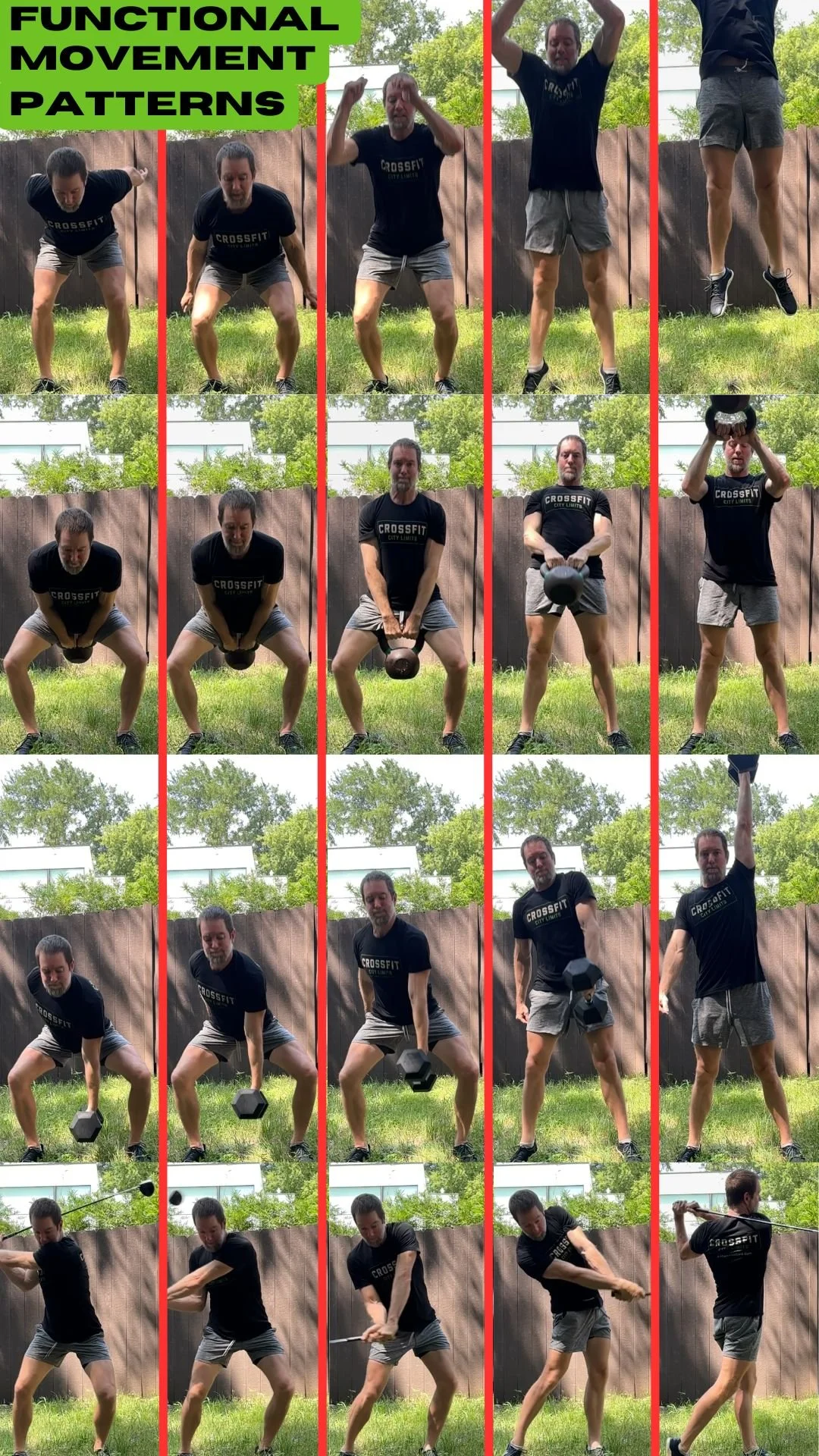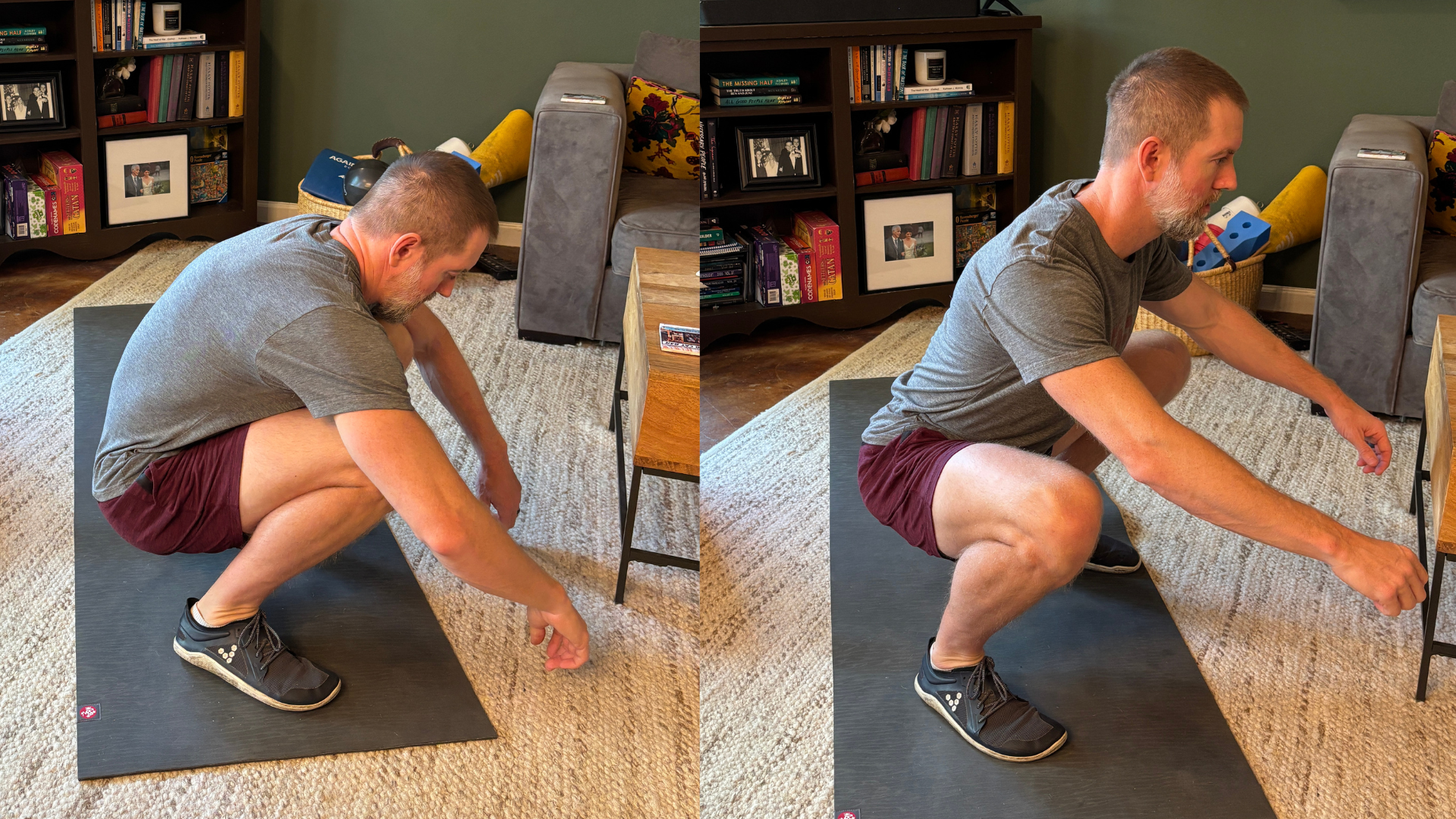”Functional Exercises” Must Be Done in Functional Ways
Written by Kyle Ligon - MovementLink Head Coach
Every human movement, even sport-specific skills performed at world-class levels, can stem from a few, core functional movement patterns. In the example photo below, I show that a jump, a Kettlebell Swing, a DB One-arm Snatch, and a golf swing, are all efficiently and effectively performed using slight variations of our jumping movement pattern.
Unlike exercise sports, like powerlifting, Olympic weightlifting, kettlebell sport, and even CrossFit whose objectives are scores in competitions centered around gym exercises, the ultimate goals that guide MovementLink’s exercise philosophy are the results that will have a maximal impact on your life outside of the gym.
MovementLink’s Non-Negotiable Fitness Goals:
real-world, functional performance
body composition
tissue & joint health
overall health & wellness
I consider workout programs that target these specific goals to be functional fitness programs and workout programs that target workout scores to be exercise sports. To achieve the above goals, which I consider to be non-negotiable, we not only need to select appropriate exercises (functional exercises), but the techniques we adopt when performing those exercises need to transfer directly into how we move our bodies in our real lives - we call these functional movement patterns. In the above photo, you can see how these functional movement patterns transfer not only across exercises in the gym, but out into the real world.
Most people, even those who think they are following a functional fitness program, are actually performing exercises that could be functional, but are using techniques that prioritizes exercise sport scores instead of prioritizing the development of functional movement patterns. To give a quick example, the technique I show above with the kettlebell swing is not the only kettlebell swing technique to choose from. In fact, the most kettlebell people in the fitness community, those who train in and compete in something called Kettlebell Sport, do not use the same technique I use. Instead of using a jumping pattern (which I demonstrate in the photo above), they use a hard hip hinge (like the very top of a deadlift). Why is there a difference? Because their technique is designed to maximize a score in their sport, Kettlebell Sport, where you have 10 minutes to do as many reps of a kettlebell exercise as possible without putting the kettlebell down. Their sport calls for a more paced and energy conserved technique. For me, the whole point of the kettlebell swing is about developing my jump movement pattern with explosive power. So, who’s correct? Well, we both could be! If you are competing in Kettlebell Sport, their technique is optimal, but if you are looking for as much real world transfer, the more functional kettlebell swing technique I use is more optimal.
Let’s continue exploring this idea by thinking about a golf swing - Anyone can hold a golf club and swing it at a ball, but only those who put a lot of effort into learning and practicing can swing the club effectively. We can think of calling an effective golf swing a functional golf swing. Although there are subtle differences in pros’ golf swings, there are foundational elements of technique that all the best golfers use to produce the most effective swings. This is also true for a volleyball spike, a baseball swing, a soccer kick, a tennis backhand, etc. The convenient thing for us humans, which is the topic of this article, is that you can insert any sport-specific skill or any real-world task and find the same few functional movement patterns at the core of any quality technique.
This is the power of understanding and developing functional movement patterns. They not only can be used in anything, but exist among the techniques of the best in the world in any sport.
My definition of functional movement is moving our body in a way that completes a task that we are likely to encounter in our lives in a highly effective and efficient way. Is picking something off the floor functional? Just like a quality golf swing requires technique, for me to qualify how I choose to pick something up off the floor as a functional movement, I would need to use an efficient and effective technique. There are many different ways to pick something up off the floor, but only a few that I would consider functional, so just because I’m picking something up off the floor does not inherently mean it is a functional exercise.
The point I want to emphasize here is that even though there are infinite ways to swing a golf club, pick up something off the floor, spike a volleyball, etc., there is typically only one style that is the most efficient, and therefore what I would consider functional. These also include gym exercises. There are infinite ways to technically do kettlebell swings, back squats, deadlifts, cleans, pull-ups, etc., but only one technique that makes performing these exercises optimally functional.
This thinking can take you a level beyond what most people are doing in the gym and is extremely powerful. By training with functional technique in your workouts, every rep also lays a foundation for any sport, hobby, activity, you are interested in, or may become interested in.
Unfortunately, most people you’ll see in gyms are performing exercises that could be functional, but using techniques that are not functional. Instead of using techniques that mimic how we move our body in the real world, people are using techniques designed specifically for getting the best scores in exercise sports like powerlifting, bodybuilding, Olympic weightlifting, kettlebell sport, and CrossFit.
What’s the difference? The end goal of these exercise sports is a score within the rules and rep standards of their sport. The fallacy is that when people get better scores in these exercise sports, those results transfer optimally into their real life. The reality is that the closer your gym technique is to how you would need to move in the real world, the better your fitness will transfer into your real life. We’ve all seen that super ripped guy with no athletic ability. They’re very fit, but not functionally fit.
Let’s say you are back squatting and wearing gear like a weight belt, a squat suit, knee sleeves, and weightlifting shoes with an elevated heel. Let’s say you take a very wide stance, turn your feet out, and squat down exactly to parallel on every rep. I could potentially qualify this as high-quality back squat technique…if you’re a competitive powerlifter. But does any of this sound like what you would be wearing or how you would move on the football field, pickleball court, or when you’re in the grocery store?
Does this technique for a back squat best mimic and challenge the most useful for real life squatting movement patterns? No. Then why does the internet and why do so many coaches and advanced athletes squat like this? Because this style and gear can help get you the highest back squat max and there is a disconnect in logic about how achieving the maximum score in an exercise variation used in a powerlifting competition transfers to our lives outside of the gym.
We tend to look at the “best” squatters to learn about squatting, but the issue is the “best” squatters are typically defined by the best powerlifting numbers. Yes, there’s a lot to learn from them, I have learned a ton and still continue to, but learning from them does not have to mean exactly copying every single choice they make, especially when it’s obvious that our ultimate goals may be different from their goals. We need to understand why they are making the choices they are making and customize what we learn for our own purposes. Even though we are both using a style of back squats in our workouts, we are performing them for different reasons and therefore require different techniques.
Even if you are following the MovementLink workout program from home, even though our program is centered around functional exercises, that does not ensure that the techniques you are implementing are actually using functional movement patterns. That is why this concept is so important. Once you understand what our functional movement patterns are (oversimplified as having good posture in the squat, the push-up, and the jump & land), you can start developing your technique in all exercises in ways that most mimic these movement patterns, allowing massive skill transfer across all exercises and into the real world.
One way to further understand these differences is to imagine qualifying words like “competition” or “functional” ahead of every exercise performed in the gym. Powerlifters actually do this. In their programming you may see a back squat further defined as a low-bar back squat, high-bar back squat, narrow-stance back squat, or a competition back squat, with the ladder meaning the exact technique and gear they will use in a competition. They understand there are multiple ways to back squat and purposefully use different styles in their training in ways that maximize their competition back squat numbers. It would be redundant, but in MovementLink’s programming, we could add the word “functional” in front of most exercises we perform to further define the stance, gear, and movement pattern choices we are going to make when performing the exercise.
This is yet another reason why we use the acronym F.I.I.T., For Intent, Intensity, and Technique. When viewed through this lens, when I perform a back squat, the intent is for it to be a functional back squat (most of the time, it’s OK to have some variations in your program).
Barefoot shoes because I want my feet and body to work naturally together,
No weight belt because I want my core to be strong enough to brace in the real world where I do not wear one,
No squat suit because, again, I don’t wear this gear in the real world,
A natural stance with my feet mostly forward because this is most common and powerful position when transferring back squat skill into real life, and
I squat as low as my technique can handle because I want my movement patterns to be developed across full ranges of motion. This not only improves joint health and flexibility and expands options I have for movement, but fuller ranges of motion also develop muscle better than partial ranges of motion.
Yes, if my ultimate goal was to get the highest back squat number on paper, I would make different choices, but my goal is to get the highest functional back squat number, while also balancing all of the non-negotiable exercise goals and therefore all the non-negotiable exercise stimuli:
Speed/Power/Agility
Muscle/Strength
VO2 Max/Anaerobic Thresholds
Endurance/Stamina
Mobility/Stability
Every one of these choices is determined by what is most functional or what mimics my real life as much as possible. That way, when I go to swing a golf club, or even something I’ve never tried before, the techniques I have developed in the gym get transferred into whatever activity I’m participating in. The ability to perform functional movements well gives you skills that transfer into anything and everything.
So, the takeaway is, for every exercise you perform in the gym, think about what functional movement patterns can be used and commit to those techniques that develop them, regardless of what that does to what would be your “scores” on paper.










